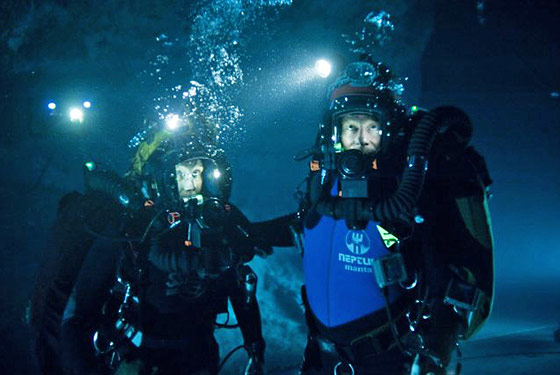
James ÔÇ£KingÔÇØ Cameron has denounced most of the 3-D films that came in the wake of Avatar ÔÇö many originally shot ÔÇ£flatÔÇØ and retrofitted ÔÇö but now has lent his name (as executive producer) and, more important, his patented newfangled motion-capture gizmos to an Aussie survival thriller called Sanctum. The acting is mostly blah, the dialogue from hunger, and there isnÔÇÖt even a clear beginning to the story ÔÇö itÔÇÖs all throat clearing ÔÇö until the first person gets killed. Then the storm arrives, the waters in the vast chain of caves near the Papua, New Guinea, coast begin to rise, and a lot more characters perish from drowning or falls or impaling or the bends. (The bends looks less fun than the impaling.) The central conflict (apart from Man versus homicidally indifferent Nature) is between resentful young Josh (Rhys Wakefield) and his big-deal cave-diver dad Frank (Richard Roxburgh), whoÔÇÖs more at home underground than in the surface world. (ÔÇ£Josh, I know I havenÔÇÖt been anything of a father to you.ÔÇØ) Director Alister Grierson reportedly had his own brush with death in an underwater cave, so for him this is serious business ÔÇö which means no Shelley Winters for bad laughs. ThereÔÇÖs not much in the way of a good time, either.
Except 
The 3-D is pretty darn good. As usual, the images are murky ÔÇö but whaddya expect, klieg lights? ItÔÇÖs a cave. ItÔÇÖs underwater. Otherwise, shot after shot is engineered to make you say, ÔÇ£Wow!ÔÇØ ThereÔÇÖs great depth of field, with textured foreground outcroppings and layers of obstructions stretching into the distance, while narrow passageways slice into the darkness. Primordial shapes rise out of the screen. Puny humans are specks amid vast, cathedral-like spaces unseen by man or beast. This is what 3-D is good at, making us dream for an instant that weÔÇÖre someplace we arenÔÇÖt and could never be.
And then the headache comes.
Roger Ebert has railed for years against 3-D and recently published a letter from the great sound editor Walter Murch, who said our brains were never meant, evolutionarily speaking, to process all these ÔÇ£shifting convergences.ÔÇØ He calls 3-D ÔÇ£dark, small, stroby, headache inducing, alienating. And expensive.ÔÇØ (Tell me about it. You pay, like, three bucks for the glasses and are then commanded to ÔÇ£recycleÔÇØ them.)
There are plenty of good counter-arguments to Murch, including one in Slate from science editor Daniel Engber, who says (IÔÇÖm way simplifying) that our brains can adapt, and who praises animated movies like Toy Story 3, where the image ÔÇ£contorts visual space into a crisscrossing, emotional depth.ÔÇØ I knew I was responding to something!
But thatÔÇÖs not how it is in these lousy retrofits, which have a way of making even filmmakers with a strong visual sense look inept. I took off my glasses halfway through Clash of the Titans, which, though blurry, became more involving. Director Louis Leterrier knows how to bring out the primordial beauty of the rocky desert landscapes ÔÇö but in bad 3-D those cliffs look like puppet stages.
Sanctum, meanwhile, wonÔÇÖt look like much on your TV screen (unless you spring for a 3-D HDTV, in which case thereÔÇÖs no help for you) but is fine for what it is. If only such movies were special occasions instead of the new normal. The irony is that most of the time, 3-D makes your brain struggle so hard that you donÔÇÖt really ÔÇ£loseÔÇØ yourself in the screen ÔÇö not in the way you do in flat but more enveloping movies. YouÔÇÖre not in the shoes of the person on the screen; youÔÇÖre the person in the seat squinting into the smudgy 3-D specs.


